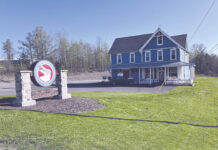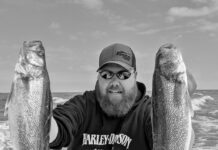I’m not a serious historian, but I’ve always enjoyed history. It comes to life when I visit locations where events have taken place or I handle items of the period. The age of America’s Minuteman has always held a special intrigue.
Armed with flintlocks and a bravery few ever muster, they faced down the most well-equipped military in the world. There was Crispus Attucks, the first patriot to fall at the Boston Massacre.
Young Deborah Sampson masqueraded as Robert Shurtiff so that she could fight British occupation. Suffering serious wounds, she became one of the first women to get a U.S. military pension. The move westward added history-makers like Jim Bridger and Jeremiah Johnson to America’s lore as they wrote their name in the Rockies while carrying the famous Hawken-styled Mountain Rifles. Talk about folks with chutzpah!
While a high schooler, I purchased a Kentucky pistol kit from colonial historian Tom Pike at his Fort Tuscarora Museum in my home county of Columbiana.
Following his dreams
A few years later, another county kid from Hanoverton headed down a similar path. At 15 years old and attending United Local, Jim Kibler came across a CVA longrifle kit at his grandmother’s house. It was a leftover from an uncle who’d lost interest in the project.
Most rural kids weren’t afraid of tackling an unfamiliar job or getting their hands dirty. Before long, he finished the rifle; if he was a fish, he’d been hooked and netted.
That first build led Jim into a hobby of studying colonial history and trying his hand at additional muzzleloader projects. Around 1990, he began carving his own stocks by hand, only purchasing some metal parts while fabricating others.
Before long, he wondered if there was a future in this sideline project. He saw other builder’s work (and the impressive prices for those historical recreations) and found little reason why he couldn’t try doing the same.
After receiving a degree in metallurgical engineering at Ohio State, he set up shop in 2009 near Hanoverton to to build custom, finely crafted colonial rifles for the most discriminating shooters and collectors.
Knocking out a rifle of high quality takes time, so paychecks came slowly. Jim learned to live within his means, but his work was becoming well-known in the historic firearm community, the Kibler name and photos of his guns appearing in national magazines. He loved the challenge of building long rifles more than the money, but cash and recognition does help. Still, he had a bit of a pipe dream.

Meeting a muse
In 2014, Katherine Werre, from Upper Sandusky, Ohio, entered the picture. On their first date, Jim talked of his idea of offering a high-quality and historically accurate long rifles in a kit form. He explained how rough the old kits were and how discouraging even some of today’s best offerings can be to a novice.
Instead of a blank stare at such “date talk,” which he should have expected, Katherine listened intently. She asked an embarrassingly simple question, “Why haven’t you started?”
That nudge likely left a dumbstruck Jim Kibler struggling to answer two internal questions, “Why haven’t I started?” and “How can I coax this woman to stick around?”
Jim soon found out that Katherine was not only willing to stick around but was also ready to bring her own skills to the table. An Ohio State alumnus with a degree in atmospheric meteorology and an accounting degree from Texas A&M, she was equipped to handle the financial storms of a new start-up business. She’d soon become vice president of Kibler’s Longrifles while Jim had found far more to love than just his long rifles. That fish was now on the stringer.
With Jim’s knowledge and Katherine’s eagerness to work and learn, the pair developed a successful business plan. The pipe dream became reality in 2015, when their first custom-quality flintlock rifle kit, the Southern Mountain Rifle, began production. They sold 225 kits that first year. A couple of years later, Kibler’s Colonial Rifle with a sliding wooden patch box was introduced.

Today, the company uses eight Computer Numerical Control machines to help recreate some of the most famous of the longrifle designs while also reducing the amount of in-shop handwork. With the first two rifles well-established, additional machining capabilities have allowed for the release of two additional kits: the “Woodsrunner” rifle, a copy of an original built in the 1760s in the Valley of Virginia, and the Fowler, a versatile smoothbore capable of serving as a shotgun and a short-range deer rifle — and as common as a hammer on frontier homesteads.
Visiting the shop
It was time for me to take a trip to my old stomping grounds and to stop by Kibler’s Longrifles and meet Jim and Katherine. Opening the door, I was corralled by the welcoming committee of the self-proclaimed emotional support goldendoodle Daisey and her buddies Biscuit and Winston. All abandoned their beds and squeaky toys for my expert ear scratches.
Visiting the shop was truly a pleasure. As an amateur historian, I had to ask if their rifles are historically correct, making me feel like I was asking Katherine if she dyed her hair.
Jim explained he’d taken a lot of time measuring and examining originals of the time period. He admits that some minor adjustments may have been made to add to the strength and quality of the firearm, but that it was as true to the designs as was feasible. This allows for variations in barrel caliber and toughened inherent weak points.
They explained one issue did become problematic — the supply of certain materials. Quality wood could be in short supply, but they’ve since contracted with Pennsylvania loggers for the rough-cut maple, cherry and walnut planks they use. The second was the locks.
When first started, Kibler’s was using high-quality locks, but they weren’t always available in the quantity required. This led Jim back to examining original designs, and soon the CNC machines were creating new lock pieces, ready to assemble on site, and ditto for the trigger assemblies.
Barrels are ordered as rifled metal tubes, to become octagonal and profiled in the shop. Much of the brass is machined to exacting specifications, requiring minimal final fitting when assembling the kit. The brass trigger guards are still formed through sand casting, but who knows?

Quality kits
How good are the Kibler kits? I don’t think you can find any that are more historically based or easier to build. The company is even offering incise decorative carving option for the Woodsrunner.
The most aggravating parts to install on muzzleloaders are the nose cap, lock and triggers. I watched as one employee test fit locks, triggers, guards and thimbles to insure proper fit on every gun. Jim grabbed a beautifully machined brass nose cap and pushed it firmly in place on a random, unfinished stock. The fit appeared flawless.
Are there more creations in the works or was the company going to take a break? I wasn’t surprised when told that a mountain rifle is planned and even a British Brown Bess or other colonial military gun is being considered.
Like many small companies, Kibler’s Longrifles is just a name to front the business. It’s really Jim and Katherine and a small group of trusted employees working hard every day. The company’s slogan is “It’s never been so easy to make history.” I found this to be true.
From my own experience, these muzzleloader kits are the absolute best I’ve seen. Expect some work, but Kibler’s kits reduce most problematic areas. Novices will find themselves capable, and experienced craftsmen will have a wonderful canvas for customization.
Everything leaving the shop — good or bad — carries the Kibler name and promise of quality, and they wear that responsibility. Is it working? According to Katherine, many customers come back for a second and even a third rifle. That’s an excellent sign. It means that people are getting what they want, that they’re filling a niche in the market.
The first year offering their kits, 225 were sold. This year they’re on track to sell 3,000 — make that 3001. You can find more information at kiblerslongrifles.com.
“Quality is never an accident. It is always the result of intelligent effort.”
— John Ruskin











